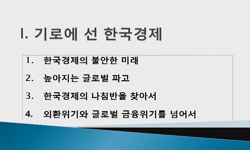In the 1980s and 1990s, analysis of the stimulants and deterrents to integration in East Asia focused on the growth of economic interactions, the networking role of firms and ethnic groups, disputes among major states, and the role of ideas. In the ne...
http://chineseinput.net/에서 pinyin(병음)방식으로 중국어를 변환할 수 있습니다.
변환된 중국어를 복사하여 사용하시면 됩니다.
- 中文 을 입력하시려면 zhongwen을 입력하시고 space를누르시면됩니다.
- 北京 을 입력하시려면 beijing을 입력하시고 space를 누르시면 됩니다.
FTA 정책형성의 정치경제: 한국, 일본, 싱가포르 비교
한글로보기https://www.riss.kr/link?id=G3791727
- 저자
-
발행기관
-
-
발행연도
2009년
-
작성언어
Korean
-
주제어
FTA ; Singapore ; Korea ; Japan ; trade governance ; multilateralism ; FTA ; bilateralism ; regionalism ; 한국 ; 일본 ; 싱가포르 ; 통상정책 ; 무역 자유화 ; 보상
-
자료형태
한국연구재단(NRF)
-
0
상세조회 -
0
다운로드
부가정보
다국어 초록 (Multilingual Abstract)
In the 1980s and 1990s, analysis of the stimulants and deterrents to integration in East Asia focused on the growth of economic interactions, the networking role of firms and ethnic groups, disputes among major states, and the role of ideas. In the new millennium, however, scholarly analysis of "formal" East Asian regionalism has focused on international political and economic factors such as the end of the Cold War, the Asian financial crisis, rising Sino-Japanese rivalry, and the like. Other scholars have emphasized that East Asian countries’ trade strategies and American strategy in the region are a reaction to the global proliferation of bilateral trade agreements in the aftermath of the problems in concluding the Doha Development Round (DDR) of the World Trade Organization (WTO). Yet this new research on the East Asian region tends to be state-centric, focusing on characterizing actors’ national interests, but without paying adequate attention to key subnational players.
Although shocks and systemic changes are key catalysts in accounting for the newfound rush to regional efforts, these explanations fall short of fully capturing the subtle but crucial differences in national responses to common external shocks. For example, South Korea turned to FTAs in the aftermath of the financial crisis, as the crisis opened up political space for executive initiative. The economic crisis muted South Korea’s once rigid protectionist voices, thus providing the government with a more favorable atmosphere for neoliberal economic reform, coupled with the adoption of PTA strategy. By contrast, FTA politics in Japan follows a different logic, as it avoided the worst of the Asian financial crisis.
As these examples suggest, South Korean, Japanese, and Singaporean preferences for FTA initiatives vary significantly. To fully understand this cross-national variance among them, researchers must give greater attention to the domestic politics in these countries, involving the interplay of government agencies, business groups, labor unions, and NGOs across the region. Specifically, we need to open the black box of each country’s decision-making process by examining how contingent shocks and critical junctures have affected coalition politics among different veto holders within and outside the government. In short, South Korea, Japan, and Singapore have embraced the rationale for FTAs to varying degrees. While these variations largely have to do with each country’s different strategic and economic positions in the global and regional system, they also stem from the fact that each country has its own way of identifying and interpreting interests shaped by policy ideas and domestic institutions.
With this backdrop, we call for a framework that helps us to explain the formation of Korean, Japanese and Singaporean FTA strategy in a dynamic and evolutionary way. We in particular shed light on how ideas, interests, and domestic institutions interact with each other in the face of external shocks. First, perceptions and ideas held by major players matter because they help policymakers and other players identify and interpret the nature of external changes, suggesting that the choice of a specific trade strategy is not an automatic response to external changes. Second, it is also crucial to examine how major players with reconfigured interests coalesce into a new trade strategy. Third, we also examine domestic institutional features related to trade strategies such as veto points, policymaking structure in the government, and institutionalized opposition to analyze how external changes and reconfigured interests are channeled in the domestic policymaking process.
국문 초록 (Abstract)
본 연구는 이러한 기존 연구의 한계를 극복하기 위하여 첫째, 동아시아 3국이 양자적 FTA로 정책전환하는 과정을 보다 세분화하여 단계별로 추적하고자 한다. 특히 다음의 여섯 단계를 중심...
본 연구는 이러한 기존 연구의 한계를 극복하기 위하여 첫째, 동아시아 3국이 양자적 FTA로 정책전환하는 과정을 보다 세분화하여 단계별로 추적하고자 한다. 특히 다음의 여섯 단계를 중심으로 한국, 일본, 그리고 싱가포르의 통상정책 변화에 대한 비교 분석을 수행하고자 한다: 1) 기존 무역레짐의 특성; 2) 국제통상환경의 변화의 성격; 3) 주요 행위자들의 인식체계와 이해관계의 변화; 4) 국내제도를 통한 이해관계의 여과 과정; 5) 주요 행위자들이 실제로 표출한 FTA에 대한 정책선호; 그리고 6) 새로운 무역레짐의 형성이 바로 그것이다. 이러한 작업은 정책의 변화가 이루어지는 과정을 보다 동태적으로 포착하는 장점이 있다.
앞에서 설명하였듯이, 한국ㆍ일본ㆍ싱가포르 3국은 전통적으로 유지하여 왔던 다자주의에 기초한 국내무역레짐에서 이탈하여 양자적 FTA로 정책전환하는 데까지는 공통점을 보였으나, 새로운 국내무역레짐을 형성하는 데 있어서는 차별성을 드러냈다. 즉, 한국, 일본, 싱가포르 3국은 위에서 설명한 과정을 거쳐 각각 차별화되는 FTA 정책을 실행하고 있다. 싱가포르의 경우, 전통적으로는 다자주의를 옹호하여 왔으나, 동아시아 국가 가운데는 FTA 선발국가로서 전방위적 FTA 체결을 빠른 속도로 추진하여 왔다. 또한 FTA의 범위와 강도 면에 있어서 기본적으로 광범위한 높은 수준의 FTA를 지향하여 왔다. 다만 상대국에 따라 FTA의 범위와 수준을 유연하게 조정하는 경우가 있는데, 일본과의 FTA가 그 대표적 사례이다. 반면, 일본은 FTA로의 정책전환을 하는 데 있어서 대단히 신중하게 점진적 접근법을 취하여 왔다. 상대국의 선택과 범위에 있어서도 역시 상당히 제한적인 면을 보이고 있다. 미국, 중국, 그리고 EU와의 FTA에 미온적인 자세를 보이고 있으며, 이미 체결된 FTA에 있어서도 농업 등 예외 분야를 설정하여 좁은 범위의 FTA를 지향하고 있는 점 등이 그 증거이다. 한국은 싱가포르 및 일본에 비해 FTA 후발국으로서 FTA로의 정책전환 자체는 뒤늦었다고 할 수 있다. 한국 정부가 ‘동시다발적 추진전략’을 수립한 이래 FTA 체결 수에 있어서 상당한 진전이 있었다. 또한 ‘거대선진경제권과의 FTA 체결’전략이 공식화하면서 FTA의 범위와 수준에 있어서도 전향적 자세를 취하고 있다. 최근에 ‘뜨거운 감자’ 대두된 한미 FTA 협상은 이러한 맥락에서 이해할 수 있다.
한국ㆍ일본ㆍ싱가포르 FTA 정책의 차별성은 어디에서 비롯되는가 3국은 모두 1990년대 초반 이후 다자주의 약화라고 하는 체제적 수준의 변화에 직면하여 새로운 통상 거버넌스를 선택을 강요받았다. 이에 따라 3국은 유사한 시기에 양자적 FTA를 수용하는 정책적 전환을 이루었던 것이다. 그러나 3국 사이에는 차별성 역시 존재한다. 싱가포르의 경우, 기존의 국내의 무역레짐이 다자주의에 상당히 의존하였던 관계로 대안 모색의 압력이 상대적으로 강하였으며, 국내 주요 행위자들의 이해관계도 빠르게 재편되었다. 또한 싱가포르 정치의 특성을 반영하듯, 국내제도 역시 비교적 신속하게 재편된 이해관계를 정책선호로 전환시키는 역할을 하였다. 따라서 싱가포르는 광범위하고 높은 수준의 양자적 FTA를 추진하는 새로운 무역레짐을 탄생시키게 된 것이다. 이에 반해 일본은 싱가포르에 비해 대안모색의 압력이 낮았을 뿐 아니라, 정치적ㆍ사회적 유대관계 및 경제적 네트워크로 인해 FTA 수용과 관련하여 재편된 주











